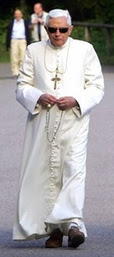Just as, sixty-three days before Easter, Septuagesima Sunday, in its lessons at Matins, begins the liturgical year with the account of the Creation in the first chapter of Genesis, and the Magnificat antiphon at first Vespers warning Adam of death should he eat the forbidden fruit, so too Candlemas concludes the liturgical year, forty days after Christmas, with its solemn celebration of the entry of the Incarnate Word into his Father's Temple, showing forth under a shadow the eternal nuptials of the Lamb and his Bride, all redeemed humanity, world without end.
The fact that Candlemas is a fixed feast, recurring every year on the 2nd of February, signifies the eternal and everlasting truth of the life of the world to come; the truth that the date of Septuagesima varies from year to year, falling on a Sunday between the 18th of January and the 22nd of February, signifies the ontologically contingent facts of the Creation and Fall, which led – O happy fault! – to the redemption of the world by our Emmanuel, and his victory over sin and death, celebrated especially during the Paschal Triduum.
Septuagesima may fall before Candlemas, or after it, or may even displace it to the Monday – but the blessing of and procession with candles falls always on the 2nd of February. The liturgical cycle may end before its next beginning, or after it begins again, signifying that the perfect consummation of all things has not yet come. Even if, in the most complete manner possible in this life, Septuagesima falls on the day after Candlemas (when Easter falls on the 6th of April, as last in 1980 and next in 2042) yet still the second Vespers of the latter overlap with the first of the latter (first Vespers of Septuagesima being commemorated after the Collect of Candlemas, and followed by the farewell to the Alleluia made at the Benedicamus Domino).
(When Septuagesima Sunday thus falls on the 3rd of February, presumably the blessing of throats at the intercession of St Blaise takes place after Septuagesima Sunday Mass.)
The processional antiphon Adorna thalamum tuum well sums up the eschatological quality of today's feast:
Adorna thalamum tuum, Sion, et suscipe Regem Christum: amplectere Mariam, quæ est cælestis porta: ipsa enim portat Regem gloriæ novi luminis: subsistit Virgo, adducens manibus Filium ante luciferum genitum: quem accipiens Simeon in ulnas suas, prædicavit populis, Dominum eum esse vitæ et mortis, et Salvatorem mundi.
(Sion, adorn your bridal chamber and welcome Christ the King; take Mary in your arms, who is the gate of heaven, for she herself is carrying the King of glory and new light. A Virgin she remains, though bringing in her hands the Son before the morning star begotten, whom Simeon, taking in his arms, announced to the people as the Lord of life and death and Saviour of the world.)







